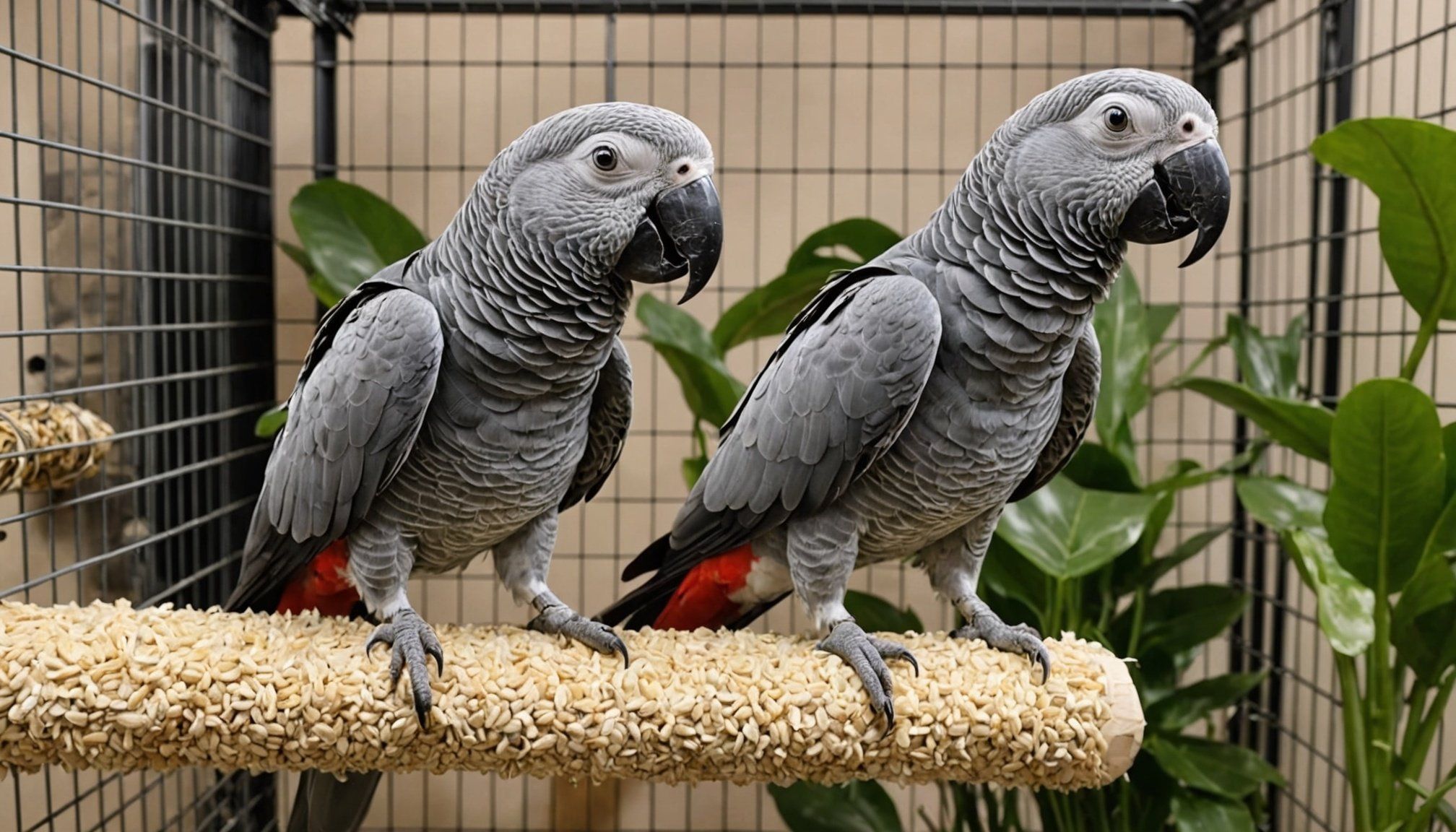Importance of a Safe and Enriching Environment
Ensuring African Grey parrots have a safe and enriching environment is crucial for their well-being. In the wild, these birds thrive in diverse habitats full of natural resources essential for their mental and physical health. Mimicking these conditions in captivity can greatly enhance their quality of life.
African Grey Parrot Habitat Overview
An African Grey parrot habitat must cater to both their safety and behavioral needs. These intelligent creatures require mental stimulation and ample room to explore. Their natural environment involves dense foliage offering both opportunities for foraging and protection from predators.
Also to see : Ultimate guide to choosing the ideal exercise wheel for your gerbil”s fitness needs
Environmental Impact on Health
A carefully curated environment impacts a parrot’s mental and physical health significantly. Without adequate space and stimulation, African Greys can develop detrimental behaviors like feather plucking. Safety is paramount, as common household items can pose threats, such as mirrors, ceiling fans, and toxic plants.
Addressing Safety Hazards
Creating a safe space for parrots involves assessing potential risks in typical home settings. Electrical cords should be concealed, and windows secured to prevent escape. Non-toxic household cleaners and bird-safe plants help mitigate risks. Providing an environment that mirrors their natural habitat ensures they remain physically active and mentally engaged.
In the same genre : Essential guide to nourishing your hyperthyroid cat: tips for a balanced, nutrient-dense diet
Cage Design and Safety Features
Designing a safe cage for African Grey parrots is fundamental to their well-being. These intelligent birds should have a living space that caters to their size and behavioral needs while ensuring safety.
Selecting the Right Cage Size and Shape
A suitable parrot cage design involves selecting the appropriate size and shape to allow for free movement. A spacious cage permits African Greys to stretch their wings fully and facilitates climbing and exploring, preventing feelings of confinement. Ensuring enough space can help diminish stress-related behaviors.
Safe Materials for Cage Construction
When choosing materials, opt for durable and nontoxic substances. Safe cage materials include stainless steel, which is resistant to corrosion and does not contain harmful chemicals. Avoid cages with zinc or lead coatings, as these can be toxic if ingested.
Essential Safety Features for Parrot Cages
Key safety features to consider are the importance of bar spacing and secure locks. Ensure bar spacing is appropriate to prevent entrapment of the bird’s head or limbs. Choose cages with non-toxic finishes and paints to avoid health risks. Secure locks and latches are essential for preventing accidental escapes, giving you peace of mind about your parrot’s safety.
Enriching Toys and Activities
Enhancing the well-being of African Grey parrots involves providing parrot toys and various enrichment activities. Engaging toys encourage natural behaviors like foraging, chewing, and problem-solving.
Types of Toys Suitable for African Grey Parrots
There is a diverse range of toys that cater to an African Grey’s intelligence and curious nature. Enrichment includes puzzle toys that challenge their mind, thus preventing boredom-induced behaviors. Additionally, swings and climbing ropes suit their playful temperament, ensuring physical exercise alongside mental engagement.
DIY Toy Ideas to Enhance Engagement
Creating DIY toys can be rewarding for both owner and bird. Simple materials like paper rolls and non-toxic wood pieces offer affordable and effective options. By creatively integrating seeds or treats inside these items, you can stimulate their foraging behaviour naturally.
Social Interaction and Playtime Essentials
Interaction is vital for African Greys. Scheduled sessions of playtime outside their cages allow for exploration and bonding. When possible, group play activities with other birds can provide companionship. Regular contact with caregivers during interactive play enhances the parrot’s emotional health and builds trust, ensuring they remain sociable and content.
Habitat Features for Mental Stimulation
The mental stimulation of African Grey parrots is crucial to their well-being, requiring thoughtful incorporation of diverse parrot habitat features. Creating varied spaces helps mimic their natural dynamic environment, starting with perches and climbing areas. Perches of different sizes and textures encourage natural perching and climbing, promoting both physical exercise and mental engagement.
Incorporating natural elements like branches, leaves, and safe wood varieties enhances the habitat, offering familiar textures and smells. These elements can simulate the parrot’s wild environment, encouraging exploratory behavior and reducing stress.
Environmental variation plays a significant role in parrot behavior. Change the layout periodically, taking into account the parrot’s curiosity and need for novel experiences. Introduce new enrichment items regularly to keep their environment exciting and engaging.
Encouraging natural foraging behaviors is another critical aspect of mental stimulation for birds. Hide seeds or food items in various areas to stimulate problem-solving skills and provide mental rewards through discovering hidden treats. This practice keeps parrots engaged and mimics their intuitive behaviors in the wild, ensuring they remain mentally fit and emotionally content within their home environment.
Common Challenges and Solutions
Caring for parrots can pose unique challenges that require expert tips for parrot health. Understanding these challenges can lead to effective and sustainable solutions.
Addressing Behavioral Issues Related to Environment
Behavioural issues often arise due to inadequate parrot habitat features. The environment plays a significant role in preventing stress-related behaviours like feather plucking. Addressing these requires introducing regular mental stimulation with enrichment activities and ensuring African Grey parrot habitat needs are met. Providing varied toys and perches can help alleviate anxiety and promote well-being.
Health Risks from Unsafe Materials
Health risks associated with unsafe materials are critical concerns that require immediate attention. Safe cage materials ensure parrot safety by using non-toxic substances like stainless steel instead of zinc or lead coatings. Regularly inspecting the habitat for toxic items is crucial for maintaining a safe space for parrots.
Expert Testimonials and Advice
Insights from avian veterinarians and experienced parrot owners offer valuable solutions. Experts recommend resources and strategies to navigate challenges in parrot care. Stories from owners who successfully adjusted environmental settings provide practical guidance, while avian specialists emphasize the importance of regular health checks and community support.











